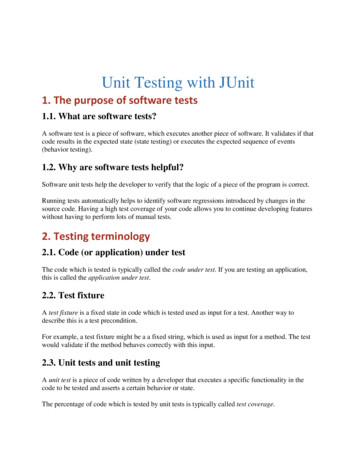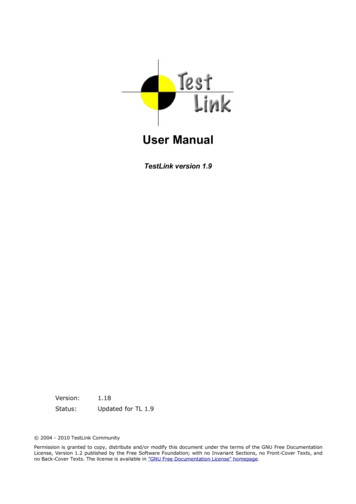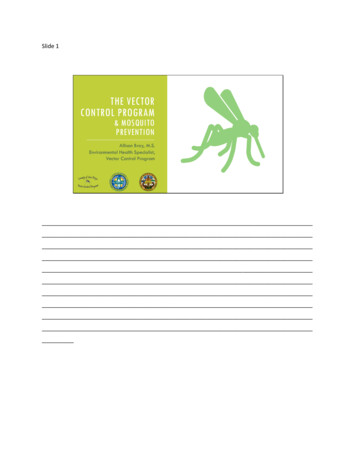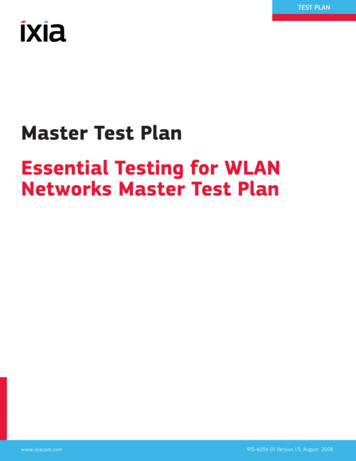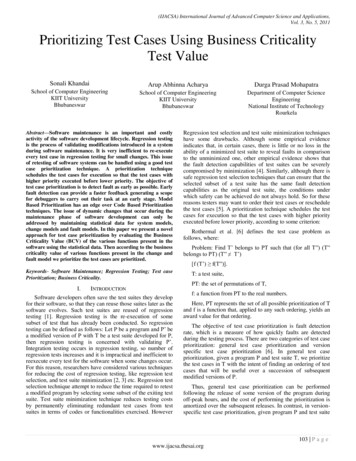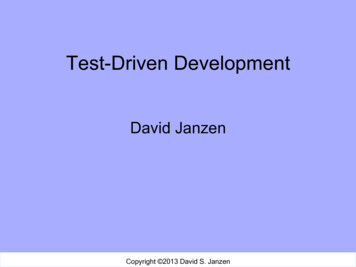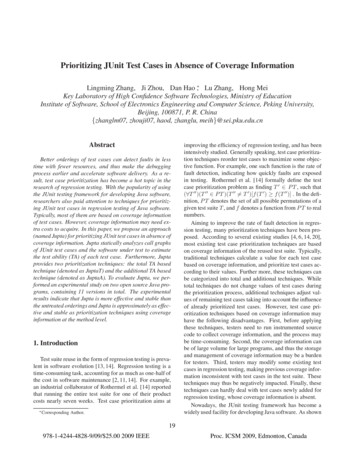
Transcription
Prioritizing JUnit Test Cases in Absence of Coverage InformationLingming Zhang, Ji Zhou, Dan Hao , Lu Zhang, Hong MeiKey Laboratory of High Confidence Software Technologies, Ministry of EducationInstitute of Software, School of Electronics Engineering and Computer Science, Peking University,Beijing, 100871, P. R. China{zhanglm07, zhouji07, haod, zhanglu, meih}@sei.pku.edu.cnAbstractBetter orderings of test cases can detect faults in lesstime with fewer resources, and thus make the debuggingprocess earlier and accelerate software delivery. As a result, test case prioritization has become a hot topic in theresearch of regression testing. With the popularity of usingthe JUnit testing framework for developing Java software,researchers also paid attention to techniques for prioritizing JUnit test cases in regression testing of Java software.Typically, most of them are based on coverage informationof test cases. However, coverage information may need extra costs to acquire. In this paper, we propose an approach(named Jupta) for prioritizing JUnit test cases in absence ofcoverage information. Jupta statically analyzes call graphsof JUnit test cases and the software under test to estimatethe test ability (TA) of each test case. Furthermore, Juptaprovides two prioritization techniques: the total TA basedtechnique (denoted as JuptaT) and the additional TA basedtechnique (denoted as JuptaA). To evaluate Jupta, we performed an experimental study on two open source Java programs, containing 11 versions in total. The experimentalresults indicate that Jupta is more effective and stable thanthe untreated orderings and Jupta is approximately as effective and stable as prioritization techniques using coverageinformation at the method level.1. IntroductionTest suite reuse in the form of regression testing is prevalent in software evolution [13, 14]. Regression testing is atime-consuming task, accounting for as much as one-half ofthe cost in software maintenance [2, 11, 14]. For example,an industrial collaborator of Rothermel et al. [14] reportedthat running the entire test suite for one of their productcosts nearly seven weeks. Test case prioritization aims at CorrespondingAuthor.improving the efficiency of regression testing, and has beenintensively studied. Generally speaking, test case prioritization techniques reorder test cases to maximize some objective function. For example, one such function is the rate offault detection, indicating how quickly faults are exposedin testing. Rothermel et al. [14] formally define the testcase prioritization problem as finding T P T , such that( T )(T P T )(T T )[f (T ) f (T )] . In the definition, P T denotes the set of all possible permutations of agiven test suite T , and f denotes a function from P T to realnumbers.Aiming to improve the rate of fault detection in regression testing, many prioritization techniques have been proposed. According to several existing studies [4, 6, 14, 20],most existing test case prioritization techniques are basedon coverage information of the reused test suite. Typically,traditional techniques calculate a value for each test casebased on coverage information, and prioritize test cases according to their values. Further more, these techniques canbe categorized into total and additional techniques. Whiletotal techniques do not change values of test cases duringthe prioritization process, additional techniques adjust values of remaining test cases taking into account the influenceof already prioritized test cases. However, test case prioritization techniques based on coverage information mayhave the following disadvantages. First, before applyingthese techniques, testers need to run instrumented sourcecode to collect coverage information, and the process maybe time-consuming. Second, the coverage information canbe of large volume for large programs, and thus the storageand management of coverage information may be a burdenfor testers. Third, testers may modify some existing testcases in regression testing, making previous coverage information inconsistent with test cases in the test suite. Thesetechniques may thus be negatively impacted. Finally, thesetechniques can hardly deal with test cases newly added forregression testing, whose coverage information is absent.Nowadays, the JUnit testing framework has become awidely used facility for developing Java software. As shown19978-1-4244-4828-9/09/ 25.00 2009 IEEEProc. ICSM 2009, Edmonton, Canada
of coverage information.Test Suitetest-classtest-classtest-classtest-class leveltest evel test cases Empirical evaluation of the proposed approach together with the total and the additional techniquesbased on method coverage, indicating that our approach is as effective as test case prioritization techniques based on coverage information.The rest of this paper is organized as follows. Section 2presents an example. Section 3 presents the details of ourapproach. Section 4 presents an experimental study. Section 5 presents related work. Section 6 concludes and discusses some future issues.Figure 1. JUnit test suite structurein Figure 1 [4], JUnit has two levels of test cases: the testclass level and the test-method level. The study by Do etal. [4] shows that traditional test case prioritization techniques can also be effective for prioritizing JUnit test cases.Besides, the study also shows that there is no much difference between test case prioritization at the test-methodlevel and that at the test-class level. In this paper, we focuson prioritization at the test-method level, and the investigation of prioritization at the test-class level should be similar.For the ease of presentation, we refer to test-method leveltest cases simply as JUnit test cases in the rest of this paper.Different from traditional test case formats, a JUnit test caseis a piece of executable source code containing some testing content (i.e., a sequence of method invocations). Thus,we can obtain the information of which methods each JUnit test case invokes, and use the information to guide theprioritization process.In particular, we propose Jupta, an approach for prioritizing JUnit test cases based on statically analyzing the sourcecode of JUnit test cases and the software under test withoutusing any previous coverage information. In our approach,we define a metric to measure the testing ability (TA) ofeach JUnit test case, and use the TA values to guide theprioritization process. Analogous to traditional techniques,we present the total technique (named JuptaT) and the additional technique (named JuptaA) based on TA. To evaluateour approach, we performed an experimental study on twoopen source Java programs that have 11 versions in total.The experimental results indicate that Jupta is a competitiveapproach for prioritizing JUnit test cases. First, JuptaT andJuptaA outperform the untreated orderings by 23.95% and70.81%, respectively. Second, JuptaT achieves 1.07% lessthan the total technique based on method coverage, and JuptaA achieves 1.62% less than the additional technique basedon method coverage, indicating that Jupta is approximatelyas effective as the widely used techniques based on methodcoverage.In summary, this paper makes the following main contributions: An approach for prioritizing JUnit test cases in absence202. ExampleFigure 2 depicts the source code of a Java class namedAccount (Figure 2 (a)) and the JUnit code for testing classAccount (Figure 2 (b)). Class Account represents a bankaccount, containing a constructor and six methods in chargeof different operations for the bank account. To test classAccount, we have six JUnit test cases (i.e., test1, test2,test3, test4, test5, and test6) depicted in Figure 2 (b). Theproblem is how to schedule the six test cases in an order thatcan expose faults early.Although we have no coverage information, we canstill have some clues by analyzing the source code of theprogram under test and the test cases. First, test1 testsonly method setBalance and test2 tests only getBalance,as the two test cases invoke only the two methods, respectively. Second, test3 tests deposit, getBalance, andsetBalance, as test3 directly invokes deposit, whichthen invokes getBalance and setBalance. Third, test4tests withdraw, getBalance, and may test setBalance,as test4 invokes withdraw and getBalance directly,and withdraw may invoke setBalance. Fourth, test5tests withdraw, sendto, getBalance, and may testsetBalance, as test5 invokes withdraw and sendtodirectly, and withdraw invokes getBalance and maytake a branch to invoke setBalance. Finally, test6tests transf er, withdraw, getBalance, and may testsetBalance, sendto. With the preceding analysis, we canacquire information in the following two categories: Which test cases may be more likely to expose morefaults? Let us consider test cases test1 and test6.Test case test6 may be more likely to expose morefaults in Account. The reason is that test6 may exposefaults in transf er, withdraw, sendto, getBalance,and setBalance, while test1 can only expose faultsin setBalance. Thus, when prioritizing the six testcases, we may consider ordering test6 before test1. Can some test cases be representative for others?Let us consider test cases test2 and test3. Ac-
public class Testcases{Account a;protected void setUp(){a new Account(100.0,"user1");}protected void tearDown(){}public class Account{private String thisAcnt;private double balance;public Account(String acnt,double amt){this.balance amt;this.thisAcnt acnt;}public double getBalance(){return this.balance;}public void setBalance(double balance){this.balance balance;}public boolean deposit(double amt){setBalance(getBalance() amt);}public void sendto(String account){ .//send money to target account}public boolean withdraw(double amt){if(getBalance() amt&&amt 0){setBalance(getBalance()-amt);return true;}else return false;}public boolean transfer(double amt, String anotherAcnt){double fee amt*0.01;if(getBalance() amt fee&&amt 0){withdraw(amt fee);sendto(anotherAcnt);return true;}else return false;}}public void test1(){a.setBalance(30.0);//Assertions}public void test2(){a.getBalance();//Assertions}public void test3(){a.deposit(30.0);//Assertions}public void ns}public void tions}public void //Asserttions}preprocess andpostprocess for testmethod execution.Six test methods tobe prioritized.}(a)(b)Figure 2. A small program dealing with simple cases in bank account and its JUnit test casescording to the preceding analysis, test2 only testsgetBalance and test3 tests deposit, getBalance, andsetBalance. Thus, if we have already executed test3,the faults in getBalance may have been revealed bytest3, and executing test2 is not emergency, becausetest2 may only reveal the faults that have been exposedby test3. That is to say, when prioritizing the six testcases, setting test3 somewhere in an ordering shouldresult in setting test2 further behind in the ordering.According to the preceding reasoning, the source codeof JUnit test cases and the software under test can provideuseful information for test case prioritization. In fact, ourJupta approach mainly uses the preceding two categories ofinformation. First, we use the test ability to quantify the information of which test cases may be more likely to exposemore faults (Section 3.1). Second, for the additional technique of Jupta, after prioritizing each test case, we use theinformation of to what extent each remaining test case canbe represented by already prioritized test cases to adjust thetest ability of each remaining test case (Section 3.2.2).3. JuptaGiven a set of test cases (denoted as TS) containing allthe test cases initially, Jupta each time removes one test casewith the highest test ability (TA) from TS, and adds it into aprioritized suite (denoted as PS). When TS becomes empty,Jupta stops the prioritization process and returns PS. In this21section, we first present the way we calculate TA of eachtest case (Section 3.1); and then we present the two prioritization techniques based on TA calculation (Section 3.2).3.1. Calculating TAAs Jupta prioritizes test cases in absence of coverage information, we need to measure the test ability of each testcase without coverage information. From the example inSection 2, the test ability of one JUnit test case may relateto the methods called by the test case directly or indirectlyin its static call graph. Therefore, before the definition ofTA, we define the relevant relation between methods ofthe program under test and test cases as follows:Definition 1 A method m of the program under test isrelevant to a JUnit test case t, iff m is covered by the staticcall graph of t.Note that Definition 1 is symmetric. That is to say, amethod m is relevant to a test case t iff t is relevant to m.Now, we define the test ability of one test case based onDefinition 1 as follows:Definition 2 TA of test case t is the sum of FCI of methodsthat are relevant with t, i.e., F CI(m).T A(t) m γ(t)
the TS is empty. JuptaT is analogous to the total techniquebased on method coverage which prioritizes test cases according to the number of methods covered by test cases.Input: Test Case Set (denoted as TS)Output: Prioritized Suite (denoted as PS)Delaration: SlideSet: a data structure used to storetest casesGeneral Process:BeginSlideSetĸØfor each test case t in TScalculate initial TA for tend forwhile TS is not empty dofor each test case t in TSadjust TA of t taking into account the influenceof test cases in SlideSetend forselect t with the highest TA in TSif TA(t) 0.0 thenSlideSetĸØcontinueend ifTSĸTS-{t}SlideSetĸSlideSet U{t}add t to PSend whilereturn PSEnd3.2.2. Additional TA based prioritization. As shown inFigure 3, the general process of this technique is similar tothe first technique except that each time after Jupta selects atest case with the highest TA in TS, Jupta adjusts TA valuesof the remaining test cases in TS through consideration ofthe test cases in SlideSet (which stores already prioritizedtest cases). In the adjustment, the methods covered by thecall graphs of already selected test cases in SlideSet will beignored for TA calculation, because it is more likely thatthey expose the same faults exposed by the prioritized testcases. The adjustment is defined as below:Definition 3 The adjusted TA of test case t is defined in thefollowing formula:T Aadj (t) m (γ(t) Figure 3. The general prioritization processof JuptaAIn Definition 2, γ(t) denotes the set of methods relevantto t; F CI(m) is the fault containing index (abbreviated asFCI) of method m, representing the probability that m contains faults in its body. The FCI value of each method maydepend on many factors: developer ability, method complexity, changing history etc. In this paper, we treat all themethods equally, assuming that they have the same FCI values, i.e., for any two methods mi and mj in the softwareunder test, F CI(mi ) F CI(mj ) 1. In other words,we use the methods covered by static call graphs to simulate the real method coverage and propose techniques toprioritize test cases.3.2. Two techniques of Jupta3.2.1. Total TA based prioritization. Initially, TS contains all the test cases to be prioritized and PS is empty.Jupta calculates initial TA of each test case in TS based onthe call graph of the test case. Each time after Jupta selectsa test case with the highest TA in TS1 , removes the test casefrom TS, Jupta adds the test case into PS. Jupta stops when1 Ifmore than one test case have the same highest TA, Jupta randomlyselects one of the test cases with the highest TA.22 t SSF CI(m).γ(t ))In Definition 3, T Aadj (t) is the adjusted TA of t; γ(t )is the set of methods relevant with t ; F CI(m) denotes thefault containing index of m.In the prioritization process, the adjusted TA values of alltest cases in TS may be 0 but TS is not empty. The reason isthat each method in the call graph of each test case in TS iscovered by one or more call graphs of test cases in SlideSet.In such a circumstance, the remaining test cases cannot bedistinguished by their adjusted TA values. To address thisissue, as framed in Figure 3, JuptaA starts another cycle ofprioritization by clearing SlideSet. In fact, the entire prioritization process of this technique may contain many prioritization cycles, as the preceding circumstance may occurmany times.JuptaA is analogous to the additional technique based onmethod coverage which prioritizes test cases according tothe coverage of methods not covered by already prioritizedtest cases.3.3. Illustration with the exampleRothermel et al. [14] propose a metric APFD for measuring the rate of fault detection of test case prioritizationtechniques. The APFD can be computed as the followingformula:AP F D 1 1(T F1 T F2 · · · T Fm ) nm2nIn this formula, n denotes the total number of test cases; mis the total number of faults; and T Fi is the smallest numberof test cases testers have to go through in sequence until
Table 1. Fault exposing matrix of test casesdepicted in Figure 2 (b).Test Casetest1test2test3test4test5test61XXXXX2XFaults3 tring)XgetBalance()T5withdraw(double)fault i is exposed. APFD values range from 0% to 100%.For a specific test suite, n and m are specified, and thus ahigher APFD value implies that the average value of T Fi sis lower, implying a higher fault detection rate.As the total technique of Jupta is easy to understand, inthis subsection we illustrate the additional TA based technique of Jupta (JuptaA) with the example presented in Section 2, and results will be measured by the rate of fault detection using the APFD metric. For the ease of presentation,let us suppose that each of the six methods in Account contains a fault and any test case calling a method can exposethe corresponding fault.The faults exposing information of the test cases (Figure 2 (b)) is shown in Table 12 . An item with “X” denotesthat the corresponding test case can expose the corresponding fault, while an item with blank content denotes that thecorresponding test case cannot expose the correspondingfault. Now we illustrate JuptaA step by step as follows:Before prioritization, JuptaA extracts the static callgraph of each test case (shown in Figure 4). Then JuptaAcomputes the initial TA of each test case according to Definitions 1 and 2.Selection 1: In the first selection, JuptaA selects test6(which has the highest TA in TS) from TS. After the selection, SS becomes {test6}. Then, all the test cases in TS arerecalculated for their TA according to Definition 3.Selection 2: In the second selection, JuptaA selects test3(which has the highest TA in TS) from TS. After the selection, SS becomes {test6, test3}. Then, all the test cases inTS are recalculated for their TA according to Definition 3.As TA values of all test cases in TS are adjusted to 0 at thispoint, JuptaA clears SS and recalculates TA for test cases inTS.Selection 3: In the third selection, JuptaA selects test5(which has the highest TA in TS) from TS. After the selection, SS becomes {test5}. Then, all the test cases in TS arerecalculated for their TA according to Definition 3. As TA2 The faults in getBalance, setBalance, deposit, sendto, withdraw,transfer are numbered from 1 to 6, nsfer(double,String)T6Test )Figure 4. Static call graphs of test cases depicted in Figure 2 (b)values of all test cases in TS are adjusted to 0 at this point,JuptaA clears SS and recalculates TA for test cases in TS.Selection 4: In the fourth selection, JuptaA selects test4(which has the highest TA in TS) from TS. After the selection, SS becomes {test4}. Then, all the test cases in TS arerecalculated for their TA according to Definition 3. As TAvalues of all test cases in TS are adjusted to 0 at this point,JuptaA clears SS and recalculates TA for test cases in TS.Selection 5: In the fifth selection, JuptaA selects test2(which is randomly selected from the 2 test cases with highest TA in TS) from TS. After the selection, SS becomes{test2}. Then, all the test cases in TS are recalculated fortheir TA according to Definition 3.Selection 6: Finally, JuptaA selects test1 as it is the onlyremaining test case in TS.The details for each selection in JuptaA are shown in Table 2. The column “Sel” lists the numbering of selections.The column “Res” corresponds to the result of each selection. Other columns correspond to the TA value for eachtest case in each selection, where an item with “-” denotesthat the test case has been selected and an item with “*” corresponds to the test case selected in the current selection.We now get a fully prioritized test suite ( test6 test3 test5 test4 test2 test1) with JuptaA after the preceding selections. To evaluate the effectivenessof JuptaA on this example, we first use APFD to measurethe original permutation of the test cases ( test1 test2 test3 test4 test5 test6), the faults detected versus the number of test cases used is depicted in Figure 5
Table 2. The prioritization process of testcases depicted in Figure 2 3test5test4test2test1123456Table 3. Subjects#Classes #Test 57536559649877650878#Seeded Faults1012161121726151294effectiveness of Jupta, while the second research question isconcerned with the stability of Jupta.4.2. Figure 5. (a)APFD for original test case order. (b)APFD for test case order generatedby JuptaA(a). The curve represents the cumulative number of faultsdetected. The shaded area under the curve represents theAPFD value obtained by this test ordering. The APFD forthe original test ordering is 50%. Second, we use APFDto measure the test ordering ( test6 test3 test5 test4 test2 test1) generated by JuptaA. As shown inFigure 5 (b), the APFD value achieved by this test ordering) higher than thatis 88.89%, which is 77.78% ( 88.89% 50%50%achieved by the original test ordering.4. Experimental study4.1. Research questionsIn our study, we are mainly concerned with the performance of Jupta. In particular, our study aims to answer thefollowing two research questions:RQ1: Is Jupta effective averagely on evolution of software and on different software?RQ2: Is Jupta stable over evolution of software and overdifferent software?Note that the first research question is concerned with the24We used two Java programs (i.e., jtopas and ant) assubjects of our experimental study. Subject jtopas, implemented for parsing text data3 , has 5.4 KLOC (excludingcomments). Subject ant is a Java-based build tool4 , whichis similar to the widely known build tool named make except that it is extended using Java classes instead of shellbased commands. Subject ant has a scale of 80.4 KLOC.We obtained fault seeded versions of programs jtopas andant from Subject Infrastructure Repository (abbreviated asSIR) [3], which is a repository providing Java and C programs for controlled experimentation of program analysisand testing approaches. Each program has multiple versionsseeded with faults, and each version has a JUnit test suitethat was developed during software evolution, the detailsare shown in Table 3.4.3. Experimental setupTo evaluate the rate of fault detection of Jupta, we usethe APFD metric [14] to measure the performance of testcase prioritization techniques and compare Jupta againstuntreated, random techniques, as well as two widely usedmethod coverage based prioritization techniques (the totaland the additional techniques based on method coverage)over the 11 subjects. The coverage information required bytotal and additional techniques based on method coverageis obtained by instrumentation implemented with the ASMbytecode manipulation framework [1].Below is the prioritization techniques compared in ourexperimental study.3 http://jtopas.sourceforge.net/jtopas4 http://ant.apache.org
Table 4. Statistic results of APFD values obtained by UT, RT, MTT, MAT, JuptaT, JuptaAon versions of ax0.77380.83300.94640.82370.84150.8281Table 5. Statistic results of APFD values obtained by UT, RT, MTT, MAT, JuptaT, JuptaAon versions of .96010.89370.92040.96010.93080.9918 Untreated Technique (UT): the original permutationof test cases provided by original test suites of subjects. Random Technique (RT): order test cases randomly(we obtain the result for random by averaging the results of 10 random permutations). Method-total Technique (MTT): prioritize test casesbased on coverage of methods. Method-additional Technique (MAT): prioritize testcases based on coverage of methods not covered yet. Total TA Based Technique (JuptaT): prioritize testcases based on TA values of test cases. Additional TA Based Technique (JuptaA): prioritizetest cases based on TA values of test cases, and alsotake into account the influence of test cases already prioritized.4.4. Results and analysisRQ1: Is Jupta effective averagely on evolution of software and on different software?First, we evaluate the effectiveness of JuptaT and JuptaA over software evolution by analyzing the results forjtopas and ant separately. As shown in Table 4, for versions of jtopas, on average, JuptaT achieves an APFD value25of 60.70%, and JuptaA achieves 74.92%, both outperforming UT significantly. JuptaT is relatively higher than MTT(11.54% over MTT), whereas JuptaA is relatively lowerthan MAT by 7.37% on versions of jtopas. Things are different on versions of ant. Shown in Table 5, on average,JuptaT achieves an APFD value lower than MTT by 5.05%,whereas JuptaA outperforms MAT with a numerically smallimprovement (0.39%). Besides, on versions of ant, JuptaAachieves the highest APFD value among all the six techniques. In summary, we can find that the JuptaT and JuptaAperform approximately as effectively as method coveragebased techniques on versions of jtopas and ant.Second, we evaluate the effectiveness of Jupta over different software by analyzing the performance of prioritization techniques over all versions of the two programs together. Over all the 11 subjects, APFD values obtainedby UT, RT, MTT, MAT, JuptaT, and JuptaA are shown inFigure 6. For total strategy based techniques, on average,JuptaT achieves an APFD value of 61.20% while MTTachieves 61.90%. Besides, for additional strategy basedtechniques, on average, JuptaA achieves an APFD value of84.34% while MAT achieves 85.73%. To conclude, both total and additional techniques of Jupta perform as effectivelyas corresponding techniques of method coverage based prioritization.The experimental results indicate that, on average, Juptacan be as effective as coverage information based techniques. However, there are some specific circumstances thatdeserve discussion.First, analyzing the APFD values achieved by Jupta onall versions of jtopas (shown in Figure 6), we observe thatJuptaA performs better than JuptaT except on jtopas-v3.For jtopas-v3, MAT also does not perform as well as MTT.This is different from the trend in other circumstances. Wefurther checked the source code and the execution of eachtest case. We found that the main reason for the exceptionis as follows. Many faults seeded in jtopas-v3 were not exposed by the first test case covering the method containingthe faults. Thus, techniques aiming to test more untestedmethods may be less effective than techniques aiming totest the faulty methods repeatedly. For example, JuptaAranked test cases testJavaT okenizer, compareSpeed1,and testP arallelP arsing as the 1st, the 3rd, and 23rd respectively . We found that method setSource seeded witha fault was executed by test case testJavaT okenizer, buttestJavaT okenizer did not expose the fault. This faultwas not exposed until setSource was invoked when executing test case compareSpeed1. Similarly, the constructor method of StandardT okenizerP roperties was covered when executing test case testJavaT okenizer, but thefault seeded in it was not exposed until executing test casetestP arallelP arsing. The preceding two and other delaysin fault exposure significantly influence the performance
1ant-v2ant-v3ant-v4ant-v5ant-v6ant-v7ant-v8Figure 6. APFD values achieved by UT, RT, MTT, MAT, JuptaT, and JuptaA over 11 versions of jtopasand antof JuptaA on jtopas-v3. We think this indicates a weakpoint for JuptaA and additional coverage based prioritization techniques, for their effectiveness is based on the assumption that faults are very likely to be exposed when theentities containing them are executed for the first time.Second, analyzing the APFD values achieved by Juptaon versions of ant (shown in Figure 6), we find that JuptaA does not perform well on ant-v3, for its APFD valueis lower than that of UT and RT. We also find that there isa extremely high value for UT on ant-v3. It is unusual, asAPFD values achieved by UT are almost the lowest on allother subjects. After analyzing the faults seeded in ant-v3,we observe that only two of the seven seeded faults can beexposed by test cases and both the two faults can be exposedby 9 test cases with re
the JUnit testing framework for developing Java software, researchers also paid attention to techniques for prioritiz-ing JUnit test cases in regression testing of Java software. . testers need to run instrumented source code to collect coverage information, and the process may be time-consuming. Second, the coverage information can .


